Empowering NobleLeaders: Service Reflections
Thank you for joining us for another “Empowering NobleLeaders” Blog with Dr. Kristin Joos and Liz Harlan.
Reflection in life, especially when positive, is almost always beneficial. The act of reflection can increase feelings of self-perception personal purpose, and community awareness, as well as increase understanding as to one's role in the greater community. We would like to share with you the importance of reflection on service experiences and offer some insight for both faculty and students on how to do service reflections. 
While a student is volunteering, the service experience can become more meaningful through constant questioning of motivations, asking why one is helping, and keeping those ideas at the forefront of their mind. A student may maintain their motivation to help by keeping track of both the work they do, as well as their initial and ongoing reactions to their service activities. Reflection before, during, and after a service experience is key, to set goals, and to remember and document observations, emotions, and activities. The most important reflection may come after when the student connects their individual experience to the bigger picture, whether it’s a wider community or national/international issue, cultural or environmental cause, or institutional motive. With reflection and further research, a student will gain deeper understanding of oneself, their community, and society. The more one reflects on their volunteer experiences, the more one knows what they like, dislike, and can identify personal strengths. Additionally, students can then use their service reflections to decide how to channel their experiences into greater action or next steps, which can be beneficial both for the individual (e.g., explore new passions or possible career choices) and the community (e.g., organizing one river clean-up to be an ongoing project with other students and community members in the area).
How to do Service Reflections:
For students volunteering, it’s easy to get lost in the day-to-day routine. As you begin to look back on your work, here are some helpful ways to take stock and connect to the bigger picture.
Get started with three easy questions:
What? So what? and Now what? These questions are commonly paired with community service to help participants think about how to channel their experiences into action or next steps. Answer them on your own or with other volunteers.
What?
How would you describe the actual work you’ve been doing? What different types of situations have you been involved in and learned from? Whether it’s playing with kids or talking to an elderly person or filing hospital records, describe your day-to-day work.
So What?
What did these actions mean? Who did they impact? How did they impact you? How did they affect the community you worked with? How did they contribute to the larger impact your organization (or you) is making?
Now what?
Now that you’ve done your service, what are you going to do next? Are there other channels of involvement? What else would you like to know about your site or issue? How will you take this experience and put it to use helping others? What ripple effect will your experiences make for yourself and others?
How to promote service reflections and service learning for faculty:
Reflection is a key component of service learning in and out of the classroom. It can be accomplished in many different avenues that students can choose for themselves to fit their learning and creative styles. Encourage students to explore these styles and decide how they would like to record and reflect on their volunteer experience.
Each time a student volunteers, it is beneficial to take a few minutes to make notes about what they did, what they learned, and how the experience impacted them. These notes will be useful for future reflecting on experiences as well as for possible use in creating a final presentation for a class. NobleHour has an work reflection tool for students exactly for this purpose.
Engaging in conversation with others (e.g., friends, professors, family) to explain what the student has been doing and why it is important to them is another way to reflect. With a volunteer supervisor’s permission, a student may be able to take photos and document their adventures in service (there may be strict rules requiring permission and releases) and use these visuals later for reflection and sharing. NobleHour enables students to share their photos, videos, and reflections using the Contribute and Share tool. 
One of the main goals of service learning is that students will continue or expand upon their community service even after the final project is done. If students are interested in learning more about their cause or organization, people at the volunteer site are great resources for other contacts and groups that are doing similar work and organizing similar events.
To maximize the service learning curriculum, components of reflection throughout the semester for students should be interspersed in the syllabus. Class discussion, journal entry writing, online posts, article critiques on surrounding service topics, and a final demonstration or project of the students’ volunteer experiences are wonderful and diverse ways to get students engaged and thinking about their experiences.
Teachers can guide students' reflection processes in a variety of ways, including, but not limited to: discussion, role play, and journaling.
Students are encouraged to reflect on their experience and:
- Describe what happened.
- Examine the difference made.
- Discuss thoughts and feelings.
- Place experience in a larger contect.
- Consider project improvements.
- Generate ideas.
- Identify questions.
- Encourage comments from partners and recipients.
- Receive feedback.
To fulfill one of her global health minor requirements in college, Liz took a course called Core Issues in Global Health: Community Health Practice for Refugees. The professor employed a Community Based Service Learning syllabus guideline which included student-led discussions, lectures, presentations, several community guest speakers, papers, posters, and a community engagement project. The class concluded with each student creating a material (paper, art, video, or article) that described their community refugee experience and also would benefit the organization. The professor made it a class requirement to get out into the surrounding community and see for themselves the information they learned about. Liz's work as an after school tutor with Fugee’s Family outside of Emory every week for one semester created meaning for the statistics and health disparities they were learning about for refugee populations in America. She is now able to look back over her paper and final project, and remember how engaged she felt both in class and with the young refugee soccer players at the Fugee’s school house.
Service learning and service reflections are valuable student and teacher tools and provide numerous opportunities for personal growth and community service. The more these ideas and actions are incorporated into classrooms, from K-12 to higher education, the better students, communities, and the world will be.
Tune in next time for a discussion of the power of volunteering in diverse environments and with diverse people.
"Writing in the Rapids" by Julie Jordan Scott is licensed under CC BY 2.0


 If your student is always on the go and the thought of being home for four to five weeks will drive you both crazy, then consider a service trip to round out the winter break.
If your student is always on the go and the thought of being home for four to five weeks will drive you both crazy, then consider a service trip to round out the winter break.  The organization provides three simple meals, basic accommodations, and basic logistics to ensure a positive and productive experience. Volunteers must cover their own travel expenses and meals on days off. The organization has a strict minimum age policy and cannot accept volunteers under the age of 15 (14 in the Philippines). All 16 and 17 year olds must be accompanied with a responsible adult.
The organization provides three simple meals, basic accommodations, and basic logistics to ensure a positive and productive experience. Volunteers must cover their own travel expenses and meals on days off. The organization has a strict minimum age policy and cannot accept volunteers under the age of 15 (14 in the Philippines). All 16 and 17 year olds must be accompanied with a responsible adult. 

 Critics would also challenge the amount of money being put into volunteerism abroad. With the hundreds and thousands of dollars people spend for their travel and accommodations while volunteering, many warn against “the dark side of our desire to help the developing world” as put by Ian Birrel in his article “Before you pay to volunteer abroad, think of the harm you might do”. Birrel warns that “orphanages are a booming business trading on guilt [. . .] Those ‘orphans’ might have been bought from impoverished parents [. . . ]An official study found just a quarter of children in these so-called orphanages have actually lost both parents. And these private ventures are proliferating fast.” The trouble with so many more tourists wanting to enrich their vacations with volunteering is that it becomes a disturbing industry where locals can profit on Westerners’ consciences. Thousands of organizations encourage people to volunteer with their organization, but often these short excursions do more harm for local communities in the developing world. They take away jobs from skilled locals and give them to volunteers who will pay to work there. Often the money spent by volunteers to travel abroad would be better used cultivating new industries and building infrastructure to help developing nations grow, rather than keeping them dependent on the developed world.
Critics would also challenge the amount of money being put into volunteerism abroad. With the hundreds and thousands of dollars people spend for their travel and accommodations while volunteering, many warn against “the dark side of our desire to help the developing world” as put by Ian Birrel in his article “Before you pay to volunteer abroad, think of the harm you might do”. Birrel warns that “orphanages are a booming business trading on guilt [. . .] Those ‘orphans’ might have been bought from impoverished parents [. . . ]An official study found just a quarter of children in these so-called orphanages have actually lost both parents. And these private ventures are proliferating fast.” The trouble with so many more tourists wanting to enrich their vacations with volunteering is that it becomes a disturbing industry where locals can profit on Westerners’ consciences. Thousands of organizations encourage people to volunteer with their organization, but often these short excursions do more harm for local communities in the developing world. They take away jobs from skilled locals and give them to volunteers who will pay to work there. Often the money spent by volunteers to travel abroad would be better used cultivating new industries and building infrastructure to help developing nations grow, rather than keeping them dependent on the developed world.



